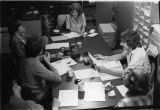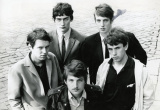Pim & Wim: Scorpio Films
The Dutch Film Academy turned out an illustrious generation of students in the mid-1960s. The leaders of this group were Pim de la Parra and Wim Verstappen, filmmakers pur sang who – together with Gied Jaspers and Nikolai van der Heyde – were also the driving forces behind the film magazine Skoop that started up in 1963.
Verstappen and De la Parra both probably felt themselves to be outsiders. Verstappen grew up on Curaçao and De la Parra came from Surinam; both of them had moved to the Netherlands just prior to attending the academy. They had similar thoughts about film production: there weren’t enough feature films being made in the Netherlands, which made it impossible to gain enough experience to be able to improve Dutch film. Their remedy for this was to make as many films as possible, with whatever (minimal) means available. By doing so, they would help create continuity in feature film production. If they’d take care of the quantity, the quality would follow.
The First Beginning
De la Parra and Verstappen started up their own film production company in March 1965: Scorpio Films. In their first year as producers, the duo immediately delivered a pair of much-discussed short films: Aaah ... Tamara, which was selected to go to Cannes, and the provocative Schermerhoorn by Mattijn Seip, which was banned by the film censorship board. The latter ended up causing a small riot, as the film had been made with money from the Ministry of Culture, Recreation and Social Work. De la Parra’s film Heart Beat Fresco was labelled as ‘impertinent’ and only just managed to be accepted by the censorship board.
Scorpio’s first feature film was shot in the spring of 1966: De minder gelukkige terugkeer van Joszef Katús naar het land van Rembrandt. Directed by Verstappen, the film was enthusiastically reviewed both at home and abroad and, out of the blue, Pim and Wim were suddenly in the international vanguard. They felt this affirmed that they were right: the film had been made for under 10,000 guilders (4,500 euros) and without a subsidy – which was completely unprecedented. This film would be followed within a couple of years by Liefdesbekentenissen and Obsessions.
On the Crest of Success
Their big blockbuster was Blue Movie. The film, about a recently released convict who discovers the pleasures of the sexual revolution in the Bijlmer district in Amsterdam, was nearly banned by the censorship board. Verstappen, who’d seen this coming, made references to Dutch writer Simon Vestdijk’s essay 'De toekomst der religie' (The Future of Religion) in the letter of objection he sent in response to the censorship board’s report. He argued that the film, as an artistic product with integrity, deserved a chance and that guarding over moral values was a hypocritical reason for banning the film. The board was persuaded by his argument and, after it was re-evaluated, the film was approved for viewers 18 years and older. The result sidelined the Centrale Commissie voor de Filmkeuring and Blue Movie went down in the books as the film that made Pim and Wim millionaires. Blue Movie was followed by films such as VD, Frank & Eva and Dakota.
The End Draws Near
Around its tenth anniversary in 1975, Scorpio was in a shambles. Verstappen said he was completely dissatisfied: he believed that Scorpio had done useful work, but that talents such as Ramses Shaffy had been ‘squandered’. As far as he was concerned, the fun was over. He’d reached the conclusion that the Netherlands was too small to produce feature films. In particular, he was furious about the disappointing attendance figures for the film he considered to be his magnus opus, Dakota, which had turned out to be very expensive to make.
De la Parra announced that he wanted to put his ‘own crazy things’ in films more often. His next feature film Wan Pipel was indeed personal: De la Parra said that with this film, he was telling all the Surinamese in the Netherlands: ‘Hey, come on back, man, what are you doing there in Holland?’
Verstappen, who’d been troubled for some time already by De la Parra’s exorbitant spending habits, couldn’t stand by and watch how the budget for Wan Pipel kept being exceeded. He left Scorpio during the production of the film. De la Parra mentioned later in the national newspaper Algemeen Dagblad that the film (in which he’d also invested his own money, in the meantime) needed to sell 400,000 tickets to break even. The film flopped and Scorpio was left with a debt of over 200,000 guilders (90,000 euros).
In 1978, it was clear to outsiders, too, that it was over: Verstappen released Pastorale 1943, which he made independent of Scorpio, and on 22 August of that year, Scorpio was declared bankrupt. De la Parra continued to feel the financial consequences for quite some time thereafter.
Although Pim and Wim had to bid farewell to their youthful dreams after the failure of Scorpio Films, they thoroughly shook up the Dutch film world with their energy and their cheeky pluck, their successful attack on film censorship and, most of all, with their ability to play out their successes and failures in the media.
more information
If you are looking for more material from our collection, please contact Film Sales:
sales@eyefilm.nl
phone +31 (0)20 5891 426




